India, France to begin contract negotiations for 26 Rafale-Marine jets this week

NEW DELHI: India will kick off official contract negotiations with France this week for the mega acquisition of 26 Rafale-Marine fighters for over Rs 50,000 crore, with the Navy keen on inducting the supersonic jets for its two aircraft carriers as soon as possible due to the expanding Chinese threat in the Indian Ocean Region.
A team of officials from the French government, fighter-manufacturer Dassault and weapon systems integrator Thales, among others, is arriving here on May 30 for the talks with the contract negotiation committee (CNC) constituted by the Indian defence ministry.
This comes after the MoD and Navy evaluated the bid or letter of acceptance (LoA) submitted by France in December in response to India’s letter of request (LoR) for the acquisition of 22 single-seat jets and four twin-seat trainers, along with weapons, simulator, spares, crew training and logistics support.
“It took time to examine the voluminous LoA with its offer, technical specifications, costs and other details. The CNC is headed by an official from the MoD acquisitions wing and includes representatives from the Navy,” an official said.
The aim is to conclude the techno-commercial negotiations and ink the government-to-government deal, after the requisite approval by the PM-led cabinet committee on security, within this financial year.
The proposed deals for the 26 Rafale-Ms and three additional Scorpene submarines to be built at Mazagon Docks for around Rs 30,000 crore were granted acceptance of necessity by the Rajnath Singh-led Defence Acquisitions Council on July 13 last year, a day before the subsequent Modi-Macron summit in Paris.
The Navy only has 40 of the 45 MiG-29K jets, inducted from Russia at a cost of $2 billion from 2009 onwards, to operate from the decks of its two over 40,000-tonne aircraft carriers, the older Russian-origin INS Vikramaditya and the new indigenous INS Vikrant. The MiG-29Ks have also been dogged by poor serviceability and other problems over the years.
With the indigenous twin-engine deck-based fighter (TEDBF) likely to take at least a decade to become operational, the Navy had pushed for the 26 Rafale-M jets as an interim measure. The IAF has already inducted 36 Rafales under the Rs 59,000 crore deal inked with France in September 2016.
China is now conducting trials of its third aircraft carrier, the over 80,000-tonne Fujian, after earlier inducting the 60,000-tonne Liaoning and the 66,000-tonne Shandong, and building more such warships.
The Indian government, in contrast, is yet to even give the preliminary nod for the long-pending case for a third 45,000-tonne aircraft carrier, let alone a more potent 65,000-tonne one, which will take at least a decade to build.
The US has 11 `super’ 90,000-100,000-tonne nuclear-powered carriers, each of which can carry 70-80 fighters and aircraft. Significantly, the Fujian — like the newest American carrier USS Gerald R Ford — has an electromagnetic catapult system to also launch much heavier aircraft for surveillance, early-warning and electronic warfare.
While the 10 US Nimitz-class carriers have steam-powered catapults, INS Vikramaditya and INS Vikrant as well as Liaoning and Shandong have only angled ski-jumps that allow fighters to take off under their own power.
